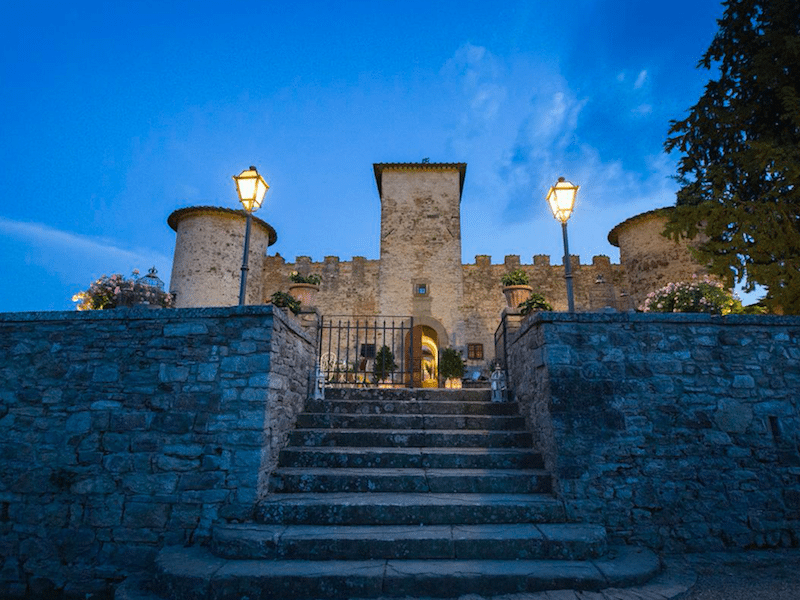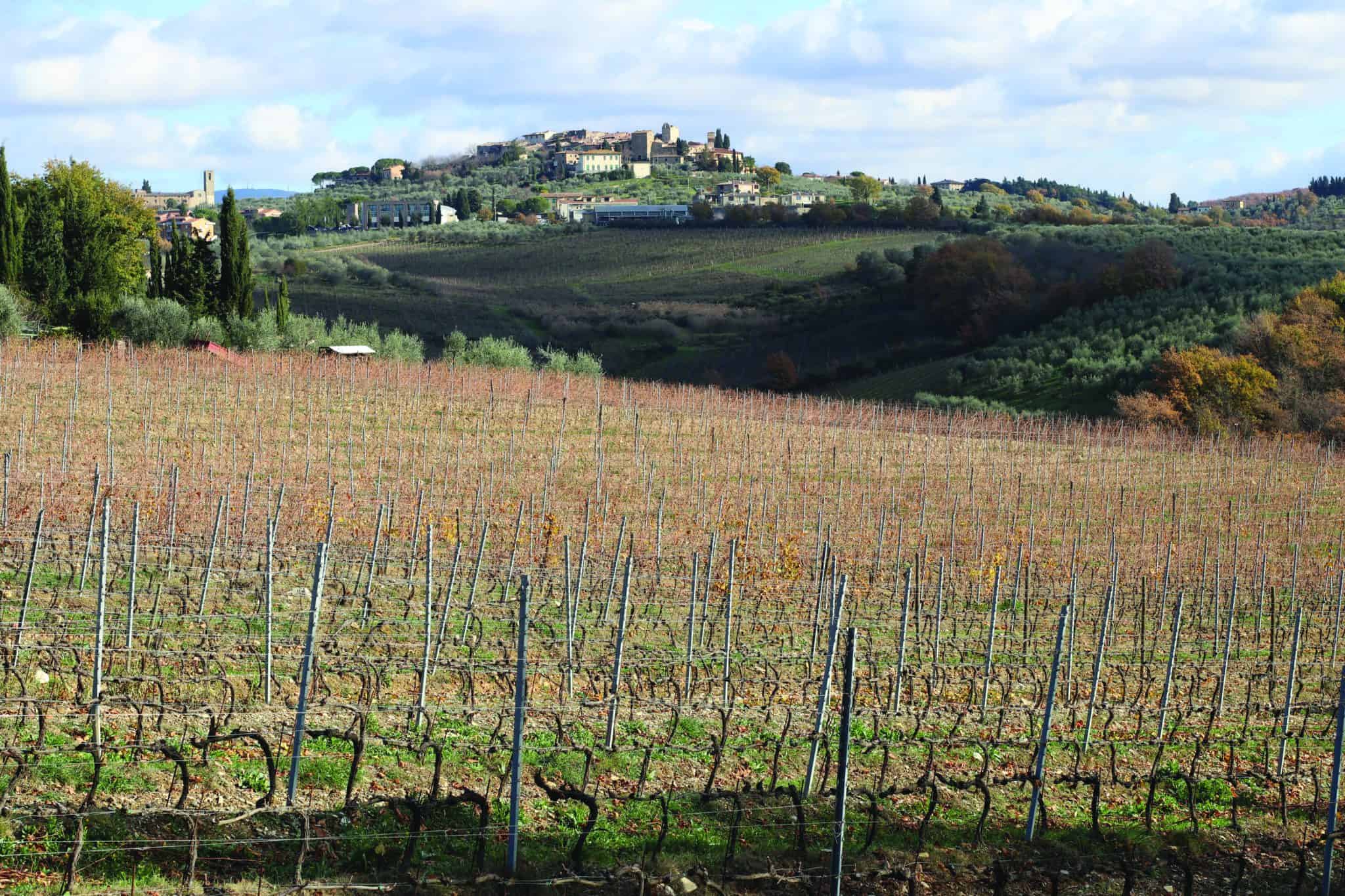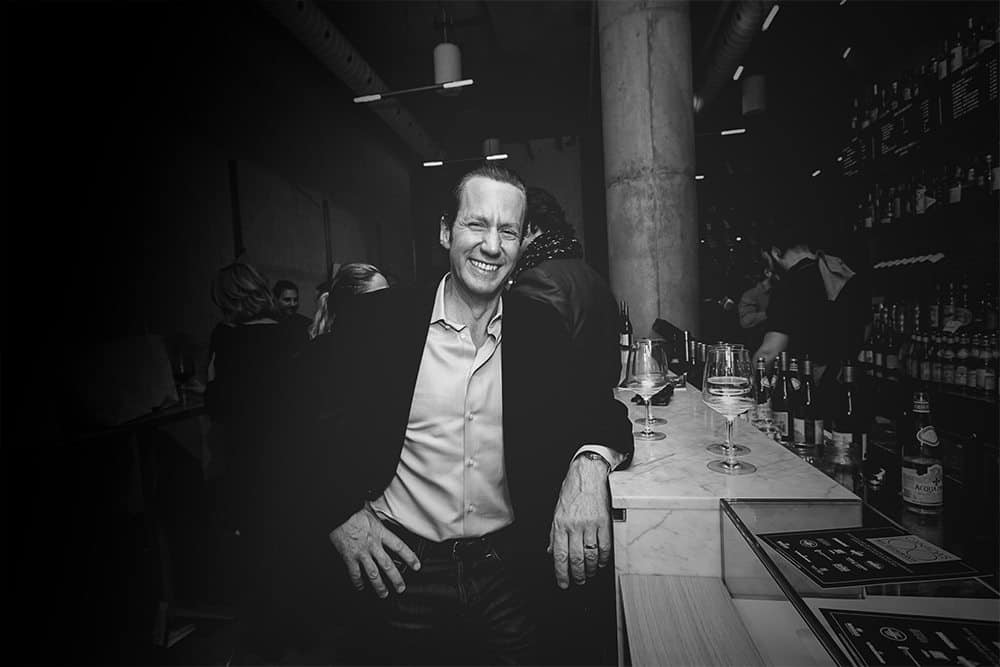
FROM HIS BASE AT CASTELLO DI GABBIANO, JACOB RICHLER EXPLORES THE ROLLING HILLS OF TUSCANY AND FINDS SPECTACULAR FOOD AND WINE, AND MANY A MAGICAL VIEW.
PART 1: THE FIRST THREE DAYS
DAY 1
ARRIVAL
There are not that many places on Earth that look as good as the best paintings and photographs we have seen of them. But all of Tuscany surely qualifies. And the vantage from Castello di Gabbiano, overlooking Chianti’s rolling hills, rows of grape- vines and patches of olive trees from 300 metres above sea level, is particularly magical. Construction on its magnificent tower—and the wine storage cellars beneath it, still in use today—began in 1124. Be assured, it is holding up very nicely indeed.
 The view from the Castello
The view from the Castello Castello di Gabbiano’s grapevines
Castello di Gabbiano’s grapevines A short while later we were tucking into artichoke frittata topped with white truffle. Then we had poached chicken neck stuffed with minced pork and pistachios, drizzled with mayonnaise. We moved on to a salad of winter greens with smoked herring fillets and a vinaigrette salted with their smoked roe. Then there was risotto al tartufo, guinea hen with truffles, and a wedge of castagnaccio…
 Chef Francesco Berardinelli at work
Chef Francesco Berardinelli at workDAY 2
TO MARKET AND BACK
It was December, off-season. The vines were bare, and the castle nearly empty—fine by us. In short, the only bad news also meant good news: as Castello di Gabbiano’s in-house restaurant Il Cavaliere was now closed for the season, executive chef Francesco Berardinelli was free to shop and cook lunch with us along for the ride.
So, come mid-morning we found ourselves at Mercato Sant’Ambrogio, on Florence’s Piazza Ghiberti, wandering about the stalls indoors and out, snacking, chatting and getting a crash course in Tuscan culinary staples. And two hours later we were back in the kitchen at the Castello, still dominated by a centuries-old, wood-burning stove cast from slabs of stone. We fanned our haul over the kitchen table, let Berardinelli assess the possibilities, took directions, and watched and learned.
A short while later we were tucking into artichoke frittata topped with white truffle. Then we had poached chicken neck stuffed with minced pork and pistachios, drizzled with mayonnaise. We moved on to a salad of winter greens with smoked herring fillets and a vinaigrette salted with their smoked roe. Then there was risotto al tartufo, guinea hen with trues, a wedge of castagnaccio—and suddenly it was 4 o’clock and time for our next appointment.
 Local flavour: poached chicken neck stuffed with minced pork and pistachios
Local flavour: poached chicken neck stuffed with minced pork and pistachios
PART 2: MIELE
Ten minutes’ drive from the Castello, at the end of a bumpy and poorly marked stretch of the Via Vallachio, there is an agriturismo named I Greppi di Silli. There, Michele Porcu welcomed us to his farm and home, and onto the stone terrace overlooking his olive grove and the valley beyond—a stunning view framed by persimmon trees. When his mother’s family bought the farm in 1934, there was nothing here but farmhouse and olive grove. The family swiftly expanded into other necessities (viticulture, pork)—and, in an initiative far less typical of the area, his grandfather added an apiary.
“For the bees,” Porcu added. “The bees that he loved very much….”
Evidently, Porcu inherited his grandfather’s passion. As the light was fading fast, he next walked us down a path through the olive grove, down the hill to the site of that original apiary. The location is still in use, albeit with new hives. Porcu explained that he extracts six different honeys from the bees on site. And in his explanation, I finally got an answer to a question I had often wondered about: are apiarists just making stuff up when they put flower-specific labels on their artisan honeys? How do they know when the bees from a certain hive have been noshing exclusively on chestnut flowers while the bees two huts down the row only catch a buzz off clover blossoms?
“I watch and see with the season,” Porcu explained.
Not the bees, the flowers. Specifically, which sort is blossoming in the fields and forest. In spring—April—a host of them bloom at once. That’s the time for millefiore (1,000 flower) honey, until the beginning of June, when the acacia starts to blossom.
“The acacia has a big, big power to call the bees to itself, so as soon as I see it I need to rescue the honey that the bees produce to this moment. So I produce the millefiore while the bees start to work with acacia. And then, as soon as the acacia owers start to die, I rescue the acacia honey and….”
On it goes—through arbutus, chestnut, eucalyptus, sunflower and cardoon. To the half-dozen types of honey he harvests from the apiary alongside his house he adds 10 more from different sites in the Chianti hills. Back at the house, we tasted a dozen, some pale, some darker than caramel, some sweet and floral, others pungent, even bitter. He makes good wines and a host of lovely olive oils, too.
 Bee boxes at I Greppi di Silli
Bee boxes at I Greppi di SilliDAY 3
WINE AND BEEF
For all the attention-grabbing super-Tuscans cast from Bordeaux-mimicking blends of varietals, the main thrust in Chianti is the improved state of the traditional, native sangiovese—along with innumerable other varietals far more obscure, once commonplace but long ago shunned for having a low yield, or simply being out of step with contemporary taste. I left I Greppi with pur-chases that included a bottle of pugnitello— an intense, all-but-forgotten red that was common in northern Tuscany in, er, Etruscan times. And now, after a magnificent tour of the 900-year-old cellars, here I was in the tasting room at Castello di Gabbiano with its charming wine-maker, Federico Cerelli, tasting his latest experiment: a 100-percent colorino, a Tuscan varietal historically deployed for lending a darker hue to Chianti blends.
The winery attached to the ancient Castel-lo is large, its product geared for export to markets like ours. But they apply small-production care to large-production wines, and the quality shows across the output [see canadas100best.com for tasting notes]. I picked a dry and balanced 2013 Chianti Classico Gran Selezione Bellezza, rich with notes of dark cherry and tobacco, leather, pepper and refined tannins to accompany my dinner.
“And bring this colorino for Dario,” Cerelli instructed as I made ready to leave his tasting room. “Dario loves everything Tuscan!”
Dario is Dario Cecchini, the world’s most celebrated butcher. If you don’t remember him from the pages of Jamie Oliver’s Jamie’s Italy or Bill Buford’s Heat, then just take it from me. Tuscan beef from the local white, massive chianina cattle is widely considered to be the best in the world. Bistecca alla Fiorentina (essentially a porterhouse) is its most prized cut. And Cecchini’s butcher shop in Panzano, Antica Macelleria, is as famous for the quality of its bistecca as it is for his purported habit of refusing to sell it to people whom he considers to be undeserving. And this was our next stop.
The tiny storefront was for once easy to find: it was advertised by a four-foot-tall red T-bone sculpture dangling from a hook and swinging in the breeze. Inside, we found Cecchini behind his raised butcher’s counter, in an apron and red velvet vest, cackling wildly and directing traffc. There was lardo on the sideboard, and sausage, and wine for everyone. When another couple turned up and let slip that they were on their honeymoon and visiting from Australia, Cecchini addressed the language barrier the best way he knew how: He put AC/DC’s “You Shook Me All Night Long” on the stereo, cranked it to 11 and jumped up and down, yelling, “Acka dacka! Acka dacka!”
In time, we were led through the storeroom, past the walk-in fridge, through a secret door, up a narrow staircase and into the Ocina della Bistecca. Cecchini’s second-floor temple of beef has communal seating for 30 and a massive wood-red grill for slow-roasting great slabs of his meat. The all-beef, all-chianina tasting menu started with a simple, hand-cut tartare, moved through a succulent, fine-fibred rump steak, then a thick-bred ribeye, rare and remarkably tender, then a bistecca panzanese—and finally, the pièce de résistance, a bistecca alla Fiorentina, a monstrous, beautiful thing that Cecchini waved about in the air while bellowing exuberantly, unleashing an incomprehensible but wildly passionate soliloquy that concluded, finally, in English: “TO BEEF… OR NOT TO BEEF?!”
To beef, please. It was all perfection. And then it got to be more so when, of all the people gathered there, Cecchini handed me the 10-cm-wide bone to gnaw on, awakening my inner caveman to a state of bliss.
 A waiter/showman at Dario Cecchini’s butcher shop, Antica Macelleria, holding its storied bistecca.
A waiter/showman at Dario Cecchini’s butcher shop, Antica Macelleria, holding its storied bistecca.


